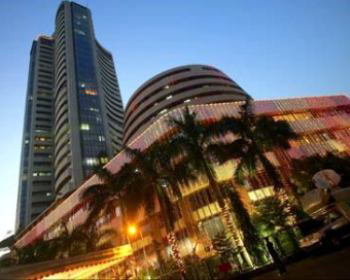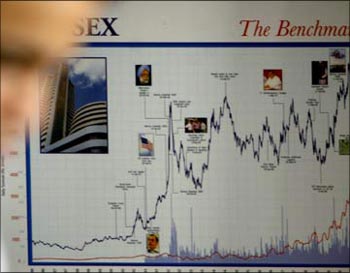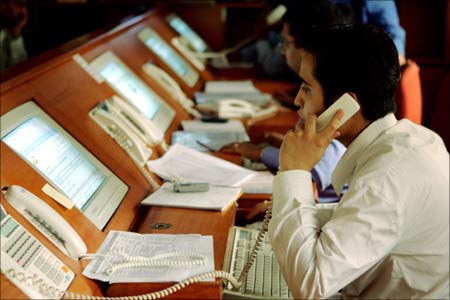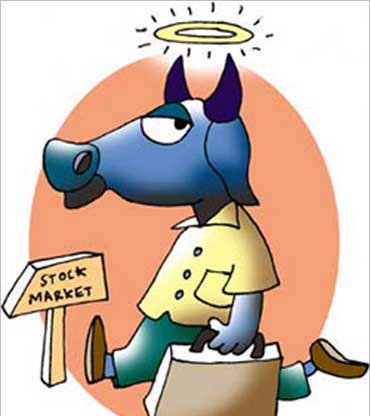Photographs: Reuters Rajesh Bhayani in Mumbai
An auspicious start for the market on the first day of the year need not mean that what begins well remains well. This is true at least for Indian equities.
Whether it was the Muhurat trading on Diwali or the beginning of the calendar year, the market fell sharply (Sensex was down 8.04 per cent) after a good start.
Still, the worst may not be over for the market.
More poison seems to be left in the Indian equities despite a nearly 10 per cent correction in the new Samvat year. The political compulsions of the government in view of the upcoming state elections are leading to a slowing of reforms.
Also, the apparent weakness in managing the rising prices of essential commodities is among the key risks. As the United States economy and markets are gaining strength and commodity prices are rising, the major driver of financial markets globally -- foreign institutional investors -- are moving towards markets whose economies are dependent on the US and commodities. They are, thus, reducing the weight of markets such as India's.
. . .
Why the worst may not be over for Indian stocks
Photographs: Reuters
Most fund managers believe that compared with last year's $29-billion inflow in the Indian markets, this year could see $18-20 billion. And, there are claimants for these reduced flows.
Manishi Raychaudhuri, Head of India Research, BNP Paribas, says, "Risks to FII flows could arise from the investors' renewed preference for north Asian markets such as China, Hong Kong, Korea and Taiwan as they are relatively cheap. Their obvious preference will also remain for economies dependent on the US recovery."
As rising commodity prices put pressure on India Inc's earnings, there are some markets that are looking attractive precisely because commodity prices are rising.
CLSA, another big FII, said recently in its report that "FII flows would shift towards emerging markets like Russia and Brazil, which are positively geared to strong commodity prices and trade at a substantial discount to the Indian market."
. . .
Why the worst may not be over for Indian stocks
Photographs: Reuters
Reflecting this shift, in the month of January, markets in Brazil, the US and Russia have gone up 2-3 per cent, while the Hang Seng is up 5 per cent. China and Taiwan are flat and India's Sensex is lower by 8 per cent.
A large domestic mutual fund's fund manager says investors are nervous because the government is looking weak in handling inflation. A worsening fiscal situation and a dismal earnings outlook, along with fears of rising interest rates, are only adding fuel to the fire.
Manishi said, "We believe several policy headwinds could slow the infrastructure build-out and derail the capex cycle."
Domestic retail investors have also exited. They are either sitting on cash or putting money in bank deposits, which is also giving above 9 per cent returns and safety of money when equities are volatile.
. . .
Why the worst may not be over for Indian stocks
Photographs: Reuters
According to data from Reserve Bank of India, currency with the public was worth Rs 65,480 crore (Rs 654.80 billion) in September-end and it went up over 30 per cent to Rs 96,293 in October and has remained high since then. Today, that figure is even higher at Rs 1,00,885 crore (Rs 1,008.85 billion), up 54 per cent compared with three months ago.
In the last one month, the aggregate deposits of banks have gone up 62 per cent. These data indicate how the public wants to play safe and keep liquidity.
This syndrome typically happens when people perceive inflation would remain high. The perception of higher inflation is always more dangerous than higher inflation itself.
Investors have not made money even in the primary market if they have not booked quick profits on listing as very few primary issues floated in 2010 are in the green today compared with their issue price.
. . .
Why the worst may not be over for Indian stocks
Photographs: Reuters
Investment bankers say in the coming months, pricing will be key to get investors' response for initial offerings.
While the government's weakness in handling inflation, the slowdown in reforms and the shift in FII flows are keeping the market down, even technically the Indian market is looking weak. "5,630 is the 200-day moving average for Nifty, which should ideally be the strong support as 200 days means virtually one year of trading. However, technical indicators suggest the Nifty may fall further in the days to come and might settle between 5,500-5,400," said Vijay Bhambwani, a technical analyst.
Rashesh Shah, Chairman, Edelweiss group, also believes some more downside is left. He says, "Economic growth is currently under threat. The market is in a downward trend and needs a major fall to bounce back and break the narrow range.
. . .
Why the worst may not be over for Indian stocks
Photographs: Uttam Ghosh/Rediff.com
Most smart high net worth individuals (HNIs) have already squared off their large positions. The bottom would be somewhere between 5,200 and 5,500 for the Nifty."
However, Manishhi of BNP has an optimistic note for the second half of the year.
He said, "2011 is likely to be a year of two halves: a muted performance by the the market in the first half and a strong recovery in the second. It is reasonable to expect that the headwinds to India's growth -- rising commodity prices, continuing tight liquidity and political uncertainty -- would be at their strongest in the first two quarters. However, after that we expect many of these headwinds to ease, in particular the tight liquidity situation and the political situation post the elections in three states (as the basic fundamentals will show their strength)".








article